- Bernard Preston homepage
- Honey Mead
- Making Honey Beer
Making honey beer
Making honey beer is one of Bernard Preston's many passions, and I guess most beekeepers have tried it with varying degrees of success.
Good or bad, it is fun trying different things in life; some are more successful than others.
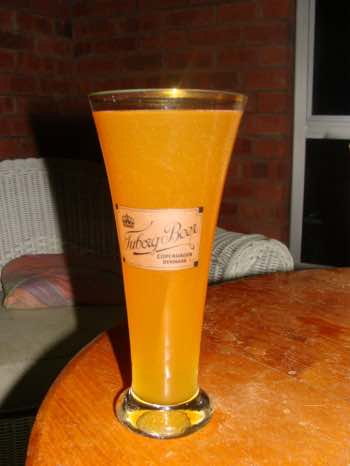
This page was last updated by Bernard Preston on 8th March, 2023.
My first efforts, some twenty five years ago were a failure because of a very basic error; yeasts do not flourish at low temperatures. Our nectar flow occurs in winter.
Surprisingly, the saligna gum tree, a eucalypti, flowers from March to June in the southern hemisphere. Brewing can be problematic when ambient temperatures are below the optimum 18 to 25 degrees Celsius that yeasts enjoy. Making honey beer is not all plain sailing.
That was a long time ago; my methods and techniques have improved. First and foremost, get the temperature right.
The second was a realisation that fungi, like humans do not flourish on a diet of simple sugars. Honey is a wonderful sweetener, particularly if you get it before the food processing industry has ruined it; but still it is a moderately glycemic carbohydrate.
The yeast-cells don't like a diet of purified honey, same as our bodies do not enjoy sugar, grains and potatoes, without the fat, vitamins and minerals that the food processing industries extract; for the benefit of their bottom line but not for our wellness.
I get around that in part by using very lightly-filtered honey which includes many pollen granules; that is where many extraordinarily beneficial metabolites may be found. They improve the flavour too of course.
I am not sure whether yeast cells can get diabetes but humans who live on a diet of highly glycemic refined carbohydrates are doomed. Do you just love chocolate-cake, white rice and soft bread rolls? There are troubles coming.
Don't fool yourself into thinking that saccharine is the solution; type "artificial sweetener side effects" into the Site Search tab in the main menu above.
So my efforts at making honey beer were less than highly successful, for reasons that were beyond me in those early-years.
Now my understanding is rather better. Like humans, yeasts need vitamins, minerals and a diet that is something more than just glycemic-carbs.
Grasping the meaning of net carbs is a big step forward in understanding sugars.
Making honey beer
Making honey beer is a good way to use up the gleanings produced after decapping your combs; if you are a beekeeper. Otherwise just a bottle of top-quality nectar will do.
Beverages these days are loaded with preservatives and other additives so this is one way to make your own and avoid the chemicals that are besieging us, and probably one of the main causes of all the metastatic disease.
One of the byproducts of beekeeping is a thick mass of honey and wax obtained from decapping the combs. These gleanings create something of a dilemma; the temptation is to put them out for the bees to again harvest the nectar but a considerable number of them die, drowned in their own food.
Also should there be any disease in the gleanings, like American Foulbrood, you would spread it to all the rest of your colonies.
Enter making honey beer.
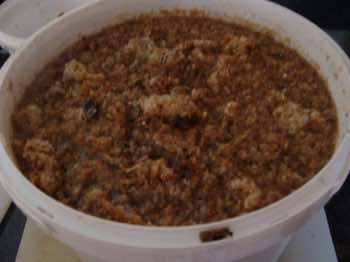
Mead is about as old as cold spring water and olive oil; and tastes just as good. It was drunk by the ancients. Beers like the t'ej made by the Ethiopians also go back into the mist of time.
I first discovered mead when I read Under the Greenwood Tree by Thomas Hardy. In the tradition of yesteryear, a young couple was always given a bottle to take on honeymoon; it was considered an aphrodisiac, certain to produce the desired result.
In this blog Bernard Preston is not going to reproduce the tried and tested method of producing an authentic mead, but rather a beer made with natural honey instead of sugar.
Therein lies the twist; the wort for making beer is always boiled to kill off any wild yeasts that may spoil the party. We are going to encourage them instead and see what we get.
So do not rush out and follow this honey beer in the making until we have tested the result.
Having said that, this is the process than makes Belgian beers so famous; they encourage the wild yeasts.
To make a home brew from basics is a trial in patience. However, making your honey beer using a kit is rather simple.
The basic principle is to obtain a wort by boiling up a concentrate of hops, add the gleanings and then the yeast. One week later you can bottle your honey beer. Measure the specific gravity if you want to calculate how strong your beer is.
Sterilise everything
Step 1 is to sterilise everything; the fermentation bucket, the airlock and bubbler and especially the tap. The easiest is to pour half a cup of household bleach into your bucket, fill with warmish water and allow it to stand of half an hour; use the plain, unscented kind.
In particular, pay attention to the fermentation lid; bubbles of honey beer from your last brew tend to dry on the lid, and it is difficult to get properly clean and will certainly be a source of wild yeast cells. Get it clean but do not scratch the plastic.
Also toss the thermometer and hydrometer into the bucket; they too need to be sterilised.
Do not dump this sterilising liquid; pour it into your quart bottles to sterilise them for bottling in a week's time.
Then rinse very thoroughly with hot water.
Dissolving the honey
Add warm unchlorinated water to the cappings to dissolve the honey, mix it up thoroughly and strain the whole into your bucket of cold spring water, and use these gleanings to make your beer; in like manner we brew our meads.
Repeat the process with a second few litres of warm water to extract as much honey as possible from the cappings.
Measure the specific gravity using a hydrometer; if it is less than 1.050 add a couple tablespoons of honey to the bucket, if you like a strong braggot.
Alternatively use a kilogram of bought honey.
Making honey beer is an art I can assure you; I have been doing it for twenty or more years.
Making the wort
There are the mysterious and heady terms associated with making honey mead, braggots and other beers; like hops and making "the wort."
Instead of hops the Ethiopians use sticks from the African dogwood tree to give a slight bitter flavour to their t'ej; countering the sweetness of the honey.
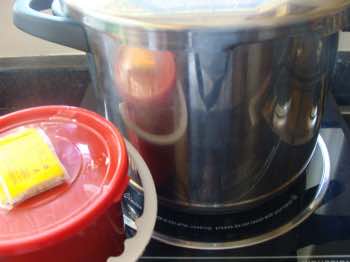
Add about three litres of boiling water to a large pot, add your concentrate which you can see in the bucket above, bring to the boil, and simmer gently for fifteen minutes. You need to stir periodically.
I have always used Coopers from Australia but, with the demise of the South African Rand, it has become prohibitively expensive. Now I am using a local beer product; it is fine; you shop around in your neck of the woods.
Cool as quickly as you can by placing the pot partly submerged in a large bucket of cold water. Leave the tap running slowly. Getting the temperature right is a vital part of making honey beer.
Cold water
If possible place your bucket on a strong table to ease bottling, or on the edge of a verandah; fill it with non-chlorinated cold water from a spring, or rainwater to about two inches below the lid to allow for bubbling.
Continuing from step 1, add the honey solution.
Add the now partially cooled wort to the spring water, pour in the strained, dissolved gleanings and immediately
- Measure the temperature: 21 - 27 *C.
- Measure the specific gravity: About 1.050, or higher if you dare. I prefer around 30.
Brewer's yeast
Provided your temperature is in the correct range, immediately sprinkle the brewer's yeast over the surface of the liquid, and seal the lid pronto.
If it is too warm add blocks of ice; try to get the temperature to 18 - 22 degrees before pitching in the yeast.
The bubbler
Pour a little gin or vodka into the bubbler, no higher than half way up the first spheres, and immediately fit it to the grommet in the lid of your fermentation bucket; you can use water, but alcohol lessens the chance of infection by wild yeasts.
Now you have to wait about a week or two, depending on the ambient temperature and how much honey you've added. Within 24 hours you should start to hear the most pleasing sound emanating from your bubbler.
The yeast cells are feasting on the honey, producing alcohol and carbon dioxide which bubbles off.
This morning fermentation started, and I'll add more information as the days progress.
Temperature
Mostly the brewing yeast operates within the range between 12 and 30 degrees; temperature control is very important. Below ten it will go dormant.
Recommended is that you pitch the yeast in when the temperature is between 18 to 22 degrees. In theory you should try to keep the wort within that range. Draping the whole in a shroud hanging in a tub of cold water will help lower the temperature.
A cleaner taste is achieved in the lower part of the range, say below 20 degrees, and more unpleasant esthers are produced if the temperature goes above 22.
Keeping a consistent temperature in the 18 to 22 range will produce a better braggot. Thus leaving your cask out at night when it gets cold, and hot during the day is not really desirable. Do you have a pantry where the good wife will allow you to keep your beer?
Otherwise, coddle it in a blanket or box insulated with newspaper or other.
If simply unable to control the temperature properly, then a lager yeast is better tolerant of wild swings.
"Wine is a turncoat; first a friend and then an enemy."
Henry Fielding
The bottles
I will do a separate page on the sterilisation of the bottles for making honey beer; there they are ready to go, with the hydrometer to check the specific gravity and a bottle of honey to prime the beer bottles. A squeeze bottle would have been better.
As a rule of thumb, one works on an attenuation of about 80%, so if your opening specific gravity was say 1040 then your should ferment to 1040 - (80/100 x 40) = 1008. If your SG is much above that on bottling add less sugar for the head, or risk a catastrophic explosion.
Use your hydrometer to check the final specific gravity is in the region of 1006. Taking beer hydrometer readings before bottling is absolutely vital. Do it, or do not brew. Flying shards of glass shrapnel can and will kill you or someone else nearby.
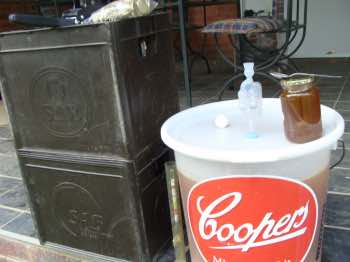
Prime each bottle with half a teaspoon of raw honey, and then fill the bottle using the tap at the bottom of the bucket, to about two inches from the top.
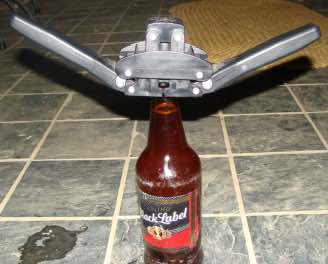
Place a cap on the bottle and use this gadget to seal your mead or beer. It is quite an art; get the handles exactly level and gently press down making sure it stays straight and level. You will break a few bottles until you get the hang of it; it is part of the art of brewing.
And finally, what we have been waiting for. Your first glass of braggot.
I have not used finings, and this is straight from the bucket so the fine particles have not yet settled out. But even now, the taste is excellent. In a month it will be heaven.
Alcohol concentration
Personally I like a light beer with an alcohol concentration of around 3%.
Sugar in grams
1000
750
500
250
Alcohol concentration
5%
4.5%
4%
3.5%
You can go lower than 250g of sugar for an even weaker beer, but you risk wild yeast infection and frankly the taste is less good.
Here is the formula to calculate the concentration:
(Original SG - Final SG)/7.46 + 0.5 for priming =% alchohol
In my case above:
(1055-1004)/7.46 + 0.5 = 51/7.46 + 0.5 = 7.3%.
Only open a quart when you have someone to share it with. It is strong stuff.
Braggot
This drink is called a braggot. It too is an ancient drink, mentioned long before Hardy, by one Geoffrey Chaucer in the fourteenth century; do you remember that great line, "for with my death the whole truth shall be seen?" It is simply a variant of making honey beer.
Newsletter
Our newsletter is entitled "create a cyan zone" at your home, preserving both yourself and Mother Earth for future generations; and the family too, of course. We promise not to spam you with daily emails promoting various products. You may get an occasional nudge to buy one of my books.
Here are the back issues.
- Lifestyle and ideal body weight
- What are ultra-processed foods?
- Investing in long-term health
- Diseases from plastic exposure
- Intensive lifestyle management for obesity has limited value
- A world largely devoid of Parkinson's Disease
- The impact of friendly bacteria in the tum on the prevention of cancer
- There's a hole in the bucket
- Everyone is talking about weight loss drugs
- Pull the sweet tooth
- If you suffer from heartburn plant a susu
- Refined maize meal and stunting
- Should agriculture and industry get priority for water and electricity?
- Nature is calling
- Mill your own flour
- Bake your own sourdough bread
- Microplastics from our water
- Alternative types of water storage
- Wear your clothes out
- Comfort foods
- Create a bee-friendly environment
- Go to bed slightly hungry
- Keep bees
- Blue zone folk are religious
- Reduce plastic waste
- Family is important
- What can go in compost?
- Grow broad beans for longevity
- Harvest and store sunshine
- Blue zone exercise
- Harvest and store your rainwater
- Create a cyan zone at your home
A braggot is stronger than most beers with an original specific gravity of over 1.060, and as high as 1.130. It is also brewed to completion with a lower SG than most beers, in the range 1.004 or less.
Take care lest it becomes the master, says Bernard Preston, and you the knave. It is a fine line.
So, that is it from making honey mead, beer and braggot. Have fun. Follow the rules and there is lots of pleasure to be had, in this instance particularly if you have access to your own raw honey.
I will do a final update on this page in a month to tell what the final making of honey beer has achieved; hopefully not a drunken old fool.
Well, we enjoyed 30 quart bottles of divine braggot. It really is good stuff, and quite cheap if you have the honey; it is an excellent way of using up your gleanings that might otherwise be wasted.
Prost.
choice foods
It is perhaps naive to describe any alcoholic beverage as a choice food, but most of us learn to drink in moderation and keep our tipple in servanthood for the majority of the time. Making honey beer, a strong braggot, is no exception.
What I find interesting is that all South African commercial beers and most wines give me dreadful indigestion; but my own brew does not.
It is the chemicals that are added to beer and wine to hasten the fermentation and preserve them that do the stomach in.
In that sense, your own entirely natural homemade beer or wine, and making honey beer, can half way be described as a nutritious choice food.
Scientists have also found that fermentation is one of the simpler methods of breaking down the tough exine coat around pollen granules; this layer inhibits access to the important nutrients.
Here is a more direct method for making a honey brown beer.
Should you feel tempted to brew your own beer or mead this is the basic equipment you will need[4].
Useful links
- Fast nutritious dinner recipes - better with a glass of mead.
- Bee under the mitre - a short story
- Glycaemic and insulinaemic properties of some German honey varieties
- Basic mead equipment
- Making carbonated session mead
Bernard Preston
Bernard Preston started keeping bees when he was only twelve; it was a tradition handed down from his grandfather who was averse to using sugar for sweetening. That was more than a half century ago. He has been making honey mead for some thirty years.
The only time in his life when he has not had a hive or three in the garden was when he was studying in Chicago. Now he has ten; that is enough for our own consumption, plenty for making honey mead, and there are never white elephants given away at Christmas.
Did you find this page interesting? How about forwarding it to a friendly book or food junkie? Better still, a social media tick would help.
- Bernard Preston homepage
- Honey Mead
- Making Honey Beer
Address:
56 Groenekloof Rd,
Hilton, KZN
South Africa
Website:
https://www.bernard-preston.com